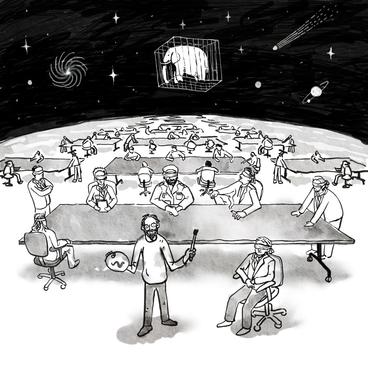
Falling asleep is a unique act of letting go of consciousness. Dreams that we see while unconscious inspire artworks, scientific theories, and rituals. Sleep is deeply cultural: decisions on when and where we are or are not allowed to sleep are driven by societal norms at least as much as by personal drives and natural cycles. When artist Peng Wu and neurologist Dr. Michael Howell talk about sleep, their conversation is not only about physiology and disorders: they talk about sleep as a culture and about sleeplessness as a cultural phenomenon that cannot be addressed with a pill.
This summer, Wu invites you to reconsider your sleep as a culture—and to fall asleep in the museum. He transforms the Target Studio for Creative Collaboration into Daydreaming Station: a peaceful and meditative environment for asking simple and complex questions about sleep. What is sleep? How do I sleep? Why am I sleepless? And then, after taking a nap in the museum, you can ask yet more questions. What did I just dream about? Was my dream art? Was I art?
Peng Wu is a design activist and interdisciplinary artist dedicated to creating socially engaged art in public space. Dr. Michael Howell is an associate professor and a leading expert in sleep in the Department of Neurology at the Medical School at the University of Minnesota. Together, they are transforming the experience of sleep and sleeplessness into art and rethinking sleep therapy by combining artistic and scientific perspectives. Daydreaming Station is an experiment that resulted from their collaboration; its elements will change during the summer as they explore questions and refine the design.
The collaboration between Wu and Dr. Howell is part of the Program on Art and Health, a collaboration between the Weisman Art Museum and the UMN Medical School. Over the past year, a poet, a sculptor, a social practice artist, and a dance artist have been collaborating with researchers in psychiatry, cardiology, neurology, and geriatric care. The humanizing change of mind from “problem” to “culture”—as in Wu and Dr. Howell’s conversations—is characteristic of all of these projects. Learn more about the program here.
Wu also collaborates this summer with the architecture collective Interesting Tactics, whose members are former and current graduate students of the UMN School of Architecture. They have designed the “Microsurface”: a piece of furniture made with living grass that acts as a chair, pillow, sitscape, tactical biome, and a place to be—a space for people, plants, animals, and all beings.
Located in the Target Studio, Daydreaming Station is open during regular museum hours. Read more about Peng Wu's Incubator Project>>



